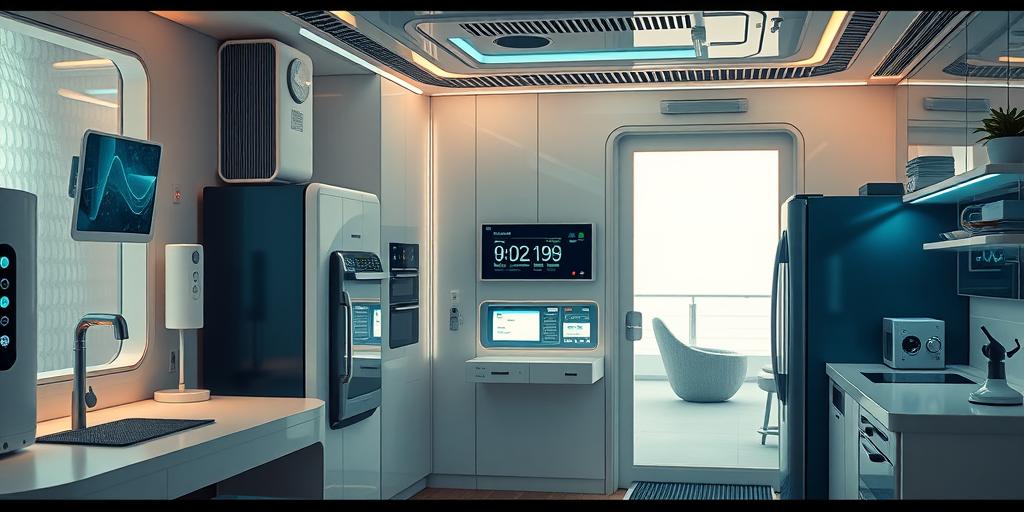Have you ever dreamed of a home that anticipates your needs before you even realize them? A home that adjusts the temperature, lighting, and entertainment based on your preferences and daily routines? This isn’t science fiction; it’s the rapidly evolving world of the Internet of Things (IoT) and smart home technology. But, can IoT really make your home smarter than you? Let’s delve into the fascinating possibilities and realities of this technological revolution.
IoT and the Smart Home: More Than Just a Gimmick
The Internet of Things (IoT) connects everyday devices to the internet, enabling them to communicate and exchange data. In the context of a smart home, this translates to everything from smart thermostats that learn your preferences to smart refrigerators that track food inventory. But, the potential goes far beyond simple convenience. Imagine a home that automatically adjusts lighting based on natural light, a security system that alerts you to potential intruders, and appliances that optimize energy consumption. This interconnectedness promises a level of home automation previously relegated to fantasy.
Enhanced Security: Peace of Mind, Automated
Forget fumbling for keys – a smart lock grants access via smartphone, fingerprint, or even facial recognition. Smart security systems go beyond simple alarms, using cameras, motion sensors, and AI to monitor your property, detecting unusual activity and alerting you in real-time. This sophisticated approach offers an unparalleled sense of security, potentially even reducing your home insurance premiums. Consider the benefits of long-range security systems and integrated video surveillance for maximum protection. These proactive measures can prevent crimes before they happen, giving you and your family the peace of mind you deserve.
Energy Efficiency: Saving Money and the Planet
Smart thermostats learn your routines and adjust the temperature accordingly, ensuring optimal comfort while minimizing energy waste. Smart lighting systems automatically dim or switch off lights when rooms are unoccupied, further reducing energy consumption. By employing IoT-enabled energy management systems, you can gain valuable insights into your energy usage patterns, pinpoint areas for improvement, and significantly lower your utility bills. The combined effect of these technologies can translate into substantial long-term cost savings and a smaller carbon footprint. You can also explore smart power strips to manage the energy consumption of multiple devices, thus effectively contributing to environmental sustainability and financial savings.
The Limits of Smart Home Technology: Reality Check
While the potential of IoT in smart homes is immense, it’s crucial to acknowledge some limitations. The initial investment in smart home devices can be significant, and the ongoing maintenance and software updates can add to the total cost. Furthermore, the reliance on internet connectivity introduces a vulnerability to cyberattacks and data breaches. A well-planned smart home setup should include robust security measures to protect sensitive data and prevent unauthorized access. Don’t underestimate the potential for malfunctions; smart home systems are complex, and glitches and malfunctions can occur, sometimes requiring professional assistance to fix.
Privacy Concerns: Protecting Your Digital Footprint
Smart home devices constantly collect data on your behavior and preferences. This raises important questions about data privacy and security. It’s essential to research the privacy policies of manufacturers and choose devices that prioritize data protection. Regularly update your software and passwords to minimize the risk of data breaches. Always be conscious of the information your devices are collecting and understand how that data is being used. Informed decision-making can help maintain your digital privacy even in an increasingly connected world. You can look for features such as end-to-end encryption, ensuring your data remains private and secure, even from the device manufacturers themselves.
Complexity and Integration Challenges
Integrating various smart home devices from different manufacturers can be challenging. Compatibility issues and different user interfaces can complicate the setup and management of a sophisticated smart home system. Thorough research into device compatibility is crucial before investing. Proper planning and a well-coordinated approach to system integration can simplify the process and eliminate many common headaches. Always prioritize seamless integration to ensure all your devices work together harmoniously for optimum efficiency and user-friendliness.
The Future of Smart Homes: A Glimpse into Tomorrow
The future of smart homes looks bright, with advancements in AI, machine learning, and automation set to further enhance the capabilities of IoT devices. Expect to see more personalized and intuitive experiences, with homes that anticipate your needs and adapt to your lifestyle even more effectively. The integration of virtual and augmented reality will likely create more immersive and engaging home environments. Furthermore, advancements in energy harvesting and sustainable technologies will contribute to the creation of more environmentally friendly smart homes. The journey towards truly smart homes is an ongoing one, and future developments promise to reshape the way we interact with our living spaces.
So, can IoT make your home smarter than you? The answer is nuanced. While it can automate tasks, enhance security, and improve energy efficiency, it requires careful consideration of privacy concerns, integration challenges, and potential costs. Ultimately, the smartness of your home isn’t just about technology; it’s about how effectively you leverage technology to enhance your comfort, convenience, and security.
Embrace the possibilities and smarten up your home today!




